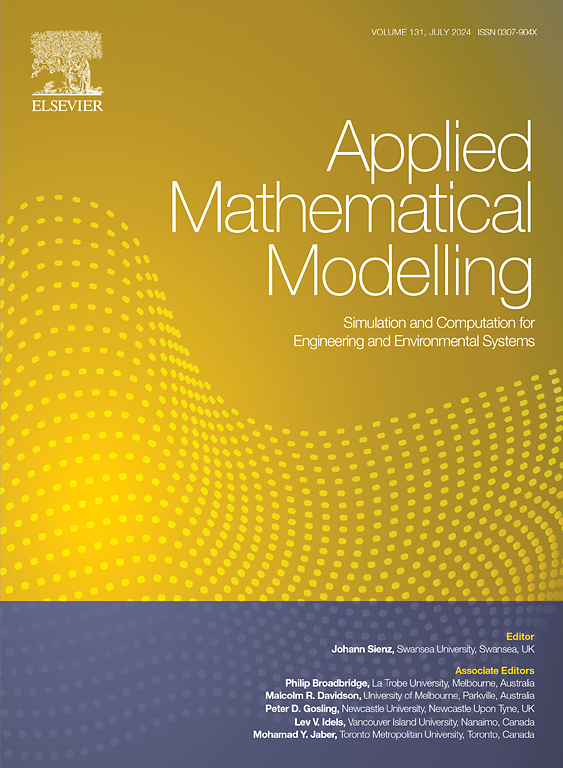Spatio-temporal grey model based on tensor Tucker decomposition for traffic flow prediction
IF 4.4
2区 工程技术
Q1 ENGINEERING, MULTIDISCIPLINARY
引用次数: 0
Abstract
Short-term traffic flow prediction plays an increasingly important role in intelligent transportation systems, providing a decision-making basis for traffic signal optimization, route guidance, and emergency control, thereby improving the efficiency of road network operation. However, the traffic flow system is a complex dynamic system, and its data has complex spatio-temporal multi-modal characteristics. The existing grey models take time series and matrix series as the input of metadata, ignoring the multi-modal characteristics of traffic flow data, and have certain limitations in capturing the spatial correlation and dynamic spatio-temporal interaction of traffic flow. This paper introduces tensors with high-dimensional multi-modal features as metadata and establishes a novel tensor-structured discrete grey model. The new model reconstructs the multi-dimensional spatio-temporal attributes of traffic flow data and traditional multi-segment traffic data, follows the discrete grey model's modeling mechanism and prediction method, and retains the advantages of fast calculation efficiency and high prediction accuracy of the grey model. It also makes up for the defect that the grey model can only handle small-scale data, providing a new idea for the multi-dimensional prediction extension of the grey model. To illustrate the effectiveness of the new model, traffic data from multiple periods and multiple road sections are simulated and predicted. The simulation effectiveness index (Mean Absolute Percentage Error) values of the new model in different periods of the same road section and the same period of different road sections are all around 5 %, and it also has a better performance compared with the other three-time series prediction models.
基于张量Tucker分解的时空灰色交通流预测模型
短期交通流预测在智能交通系统中发挥着越来越重要的作用,为交通信号优化、路线引导和应急控制提供决策依据,从而提高路网运行效率。然而,交通流系统是一个复杂的动态系统,其数据具有复杂的时空多模态特征。现有的灰色模型以时间序列和矩阵序列作为元数据的输入,忽略了交通流数据的多模态特征,在捕捉交通流的空间相关性和动态时空交互方面存在一定的局限性。本文引入具有高维多模态特征的张量作为元数据,建立了一种新的张量结构的离散灰色模型。新模型重构了交通流数据和传统多段交通数据的多维时空属性,遵循离散灰色模型的建模机制和预测方法,保留了灰色模型计算效率快、预测精度高等优点。同时也弥补了灰色模型只能处理小尺度数据的缺陷,为灰色模型的多维预测扩展提供了新的思路。为了说明新模型的有效性,对多时段、多路段的交通数据进行了模拟和预测。新模型在同一路段不同时段和不同路段同一时段的模拟有效性指数(Mean Absolute Percentage Error)均在5%左右,与其他三时间序列预测模型相比也具有更好的性能。
本文章由计算机程序翻译,如有差异,请以英文原文为准。
求助全文
约1分钟内获得全文
求助全文
来源期刊

Applied Mathematical Modelling
数学-工程:综合
CiteScore
9.80
自引率
8.00%
发文量
508
审稿时长
43 days
期刊介绍:
Applied Mathematical Modelling focuses on research related to the mathematical modelling of engineering and environmental processes, manufacturing, and industrial systems. A significant emerging area of research activity involves multiphysics processes, and contributions in this area are particularly encouraged.
This influential publication covers a wide spectrum of subjects including heat transfer, fluid mechanics, CFD, and transport phenomena; solid mechanics and mechanics of metals; electromagnets and MHD; reliability modelling and system optimization; finite volume, finite element, and boundary element procedures; modelling of inventory, industrial, manufacturing and logistics systems for viable decision making; civil engineering systems and structures; mineral and energy resources; relevant software engineering issues associated with CAD and CAE; and materials and metallurgical engineering.
Applied Mathematical Modelling is primarily interested in papers developing increased insights into real-world problems through novel mathematical modelling, novel applications or a combination of these. Papers employing existing numerical techniques must demonstrate sufficient novelty in the solution of practical problems. Papers on fuzzy logic in decision-making or purely financial mathematics are normally not considered. Research on fractional differential equations, bifurcation, and numerical methods needs to include practical examples. Population dynamics must solve realistic scenarios. Papers in the area of logistics and business modelling should demonstrate meaningful managerial insight. Submissions with no real-world application will not be considered.
 求助内容:
求助内容: 应助结果提醒方式:
应助结果提醒方式:


